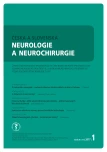Validation of Myasthenia Gravis Quality of Life Questionnaire – Czech Version of MG-QOL15
Authors:
M. Horáková; S. Voháňka; J. Bednařík
Authors‘ workplace:
Neurologická klinika LF MU a FN Brno
Published in:
Cesk Slov Neurol N 2017; 80/113(1): 66-69
Category:
Original Paper
Overview
Background:
In 2000, the Myasthenia Gravis Foundation of America task force recommended development of an MG-specific QOL measure. A 15-item Myasthenia Gravis Quality of Life 15 (MG-QOL15) scale was constructed in 2008. The questionnaire proved to be reliable and well correlated with other MG-scales (QMG, MG-ADL, MMT) and it quickly became a part of the evaluation of patients in clinical trials. The aim of our study was to establish an official Czech version, perform validation and enable the MG-QOL15 use in routine clinical practice.
Methods:
Czech translation was approved by a professional translator and then validated through forward-backward translation. Repeatability and reproducibility were tested on a sample of 40 patients. Patients completed the MG-QOL15 during a neuromuscular clinic visit and were asked to complete the second MG - QOL15 2–4 days later.
Results:
The Pearson correlation coefficient between the first and second completion was 0.993. For 95% of patients, the score did not differ by more than 2 points. Regression analysis of our data did not prove systematic bias with higher MG-QOL15 score. Cronbach alpha of 0.947 corresponds to high internal consistency of the questionnaire.
Conclusion:
The MG-QOL15 is an effective tool for monitoring the quality of life in patients with myasthenia. The official Czech translation allows the use of the questionnaire in routine clinical practice.
The authors declare they have no potential conflicts of interest concerning drugs, products, or services used in the study.
The Editorial Board declares that the manuscript met the ICMJE “uniform requirements” for biomedical papers.
Key words:
myasthenia gravis – outcome measure – quality of life – validation – questionnaire
Chinese summary - 摘要
寿命验证问卷质量患者重症肌无力 - 在MG-QOL15捷克版本摘要
简介:
2000年,工作队MGFA(美国重症肌无力基金会)推荐MG-QOL专用问卷的创建。 2008年它产生时包含15个问题并被命名为MG-QOL15的重症肌无力质量。问卷表明显著的可靠性,并与其他尺度非常好的相关性(QMG,MG-ADL,MMT)的患者在临床评价很快成为一部分研究。我们研究的目的是要建立一个正式的捷克语翻译执行其验证和主要是扩大MG-QOL15到临床实践中。
方法:
捷克语翻译被批准的专业翻译和验证方法反向翻译。重复性和再现性上的40样本测试
病人。第一份调查表,患者填写了例行检查时,并进行了一天2-4次的检查。
结果:
重复性分析用的皮尔逊系数为0.993。 95%患者有变异的两分中得分。回归分析,我们有我们的日期还没有随着总比分表现出更大的偏差。信度的值阿尔法0.947展示了调查问卷的内部一致性。
结论:
问卷的MG-QOL15是用于与监测生活质量的患者的有效工具重症。官方捷克语翻译允许在临床实践中运用问卷。
关键词:
重症肌无力 - 品种 - 生活质量 - 验证 - 专访
Sources
1. Guyatt GH, Feeny DH, Patrick DL. Measuring health-related quality of life. Ann Intern Med 1993;118(8):622 – 9.
2. Burns TM. History of outcome measures for myasthenia gravis. Muscle Nerve 2010;42(1):5 – 13. doi: 10.1002/ mus.21713.
3. Brazier JE, Harper R, Jones NM, et al. Validating the SF-36 health survey questionnaire: new outcome measure for primary care. BMJ 1992;305(6846):160 – 4.
4. Padua L, Evoli A, Aprile I, et al. Health-related quality of life in patients with myasthenia gravis and the relationship between patient-oriented assessment and conventional measurements. Neurol Sci 2014;22(5):363 – 9.
5. Paul RH, Nash JM, Cohen RA, et al. Quality of life and well-being of patients with myasthenia gravis. Muscle Nerve 2001;24(4):512 – 6.
6. Padua L, Evoli A, Aprile I, et al. Myasthenia gravis outcome measure: development and validation of a disease-specific self-administered questionnaire. Neurol Sci 2014;23(2):59 – 68.
7. Mullins LL, Carpentier MY, Paul RH, et al. Disease-specific measure of quality of life for myasthenia gravis. Muscle Nerve 2008;38(2):947 – 56. doi: 10.1002/ mus.21016.
8. Burns TM, Grouse CK, Conaway MR; MG composite and mg-qol15 study group. Construct and concurrent validation of the MG-QOL15 in the practice setting. Muscle Nerve 2010;41(2):219 – 26. doi: 10.1002/ mus.21609.
9. Burns TM, Conaway MR, Cutter GR, et al. Less is more, or almost as much: A 15-item quality-of-life instrument for myasthenia gravis. Muscle Nerve 2008;38(2):957 – 63. doi: 10.1002/ mus.21053.
10. Masuda M, Utsugisawa K, Suzuki S, et al. The MG-QOL15 Japanese version: validation and associations with clinical factors. Muscle Nerve 2012;46(2):166 – 73. doi: 10.1002/ mus.23398.
11. Ostovan VR, Fatehi F, Davoudi F, et al. Validation of the 15-item myasthenia gravis quality of life questionnaire (MG-QOL15) Persian version. Muscle Nerve 2016;54(1):65 – 70. doi: 10.1002/ mus.25002.
12. Taşcilar NF, Saraçli Ö, Kurçer MA, et al. Reliability and validity of the Turkish version of myasthenia gravis-quality of life questionnaire-15 item. Turk J Med Sci 2016;46(4):1107 – 13. doi: 10.3906/ sag-1504-97.
13. Mourão AM, Araújo CM, Barbosa LS, et al. Brazilian cross-cultural translation and adaptation of the “Questionnaire of Life Quality Specific for Myasthenia Gravis – 15 items”. Arq Neuropsiquiatr 2013;71(12):955 – 8. doi: 10.1590/ 0004-282X20130180.
14. Beaton DE, Bombardier C, Guillemin F, et al. Guidelines for the process of cross-cultural adaptation of self-report measures. Spine 2000;25(24):3186 – 91.
15. Burns TM, Grouse CK, Wolfe GI, et al, MG Composite and MG-OL15 Study Group. The MG-QOL15 for following the health-related quality of life of patients with myasthenia gravis. Muscle Nerve 2011;43(1):14 – 8. doi: 10.1002/ mus.21883.
16. Bland JM, Altman DG. Measuring agreement in method comparison studies. Stat Methods Med Res 1999;8(2):135 – 60.
17. Bland JM, Altman DG. Cronbach’s alpha. BMJ 1997; 314(7080):572.
18. Burns TM. The MG composite: an outcome measure for myasthenia gravis for use in clinical trials and everyday practice. Ann N Y Acad Sci 2012;1274 : 99 – 106. doi: 10.1111/ j.1749-6632.2012.06812.x.
19. Chmelíková M, Voháňka S, Bednařík J. Myasthenia Gravis Composite – validace české verze. Cesk Slov Neurol N 2016;79/ 112(5):585 – 90.
Labels
Paediatric neurology Neurosurgery NeurologyArticle was published in
Czech and Slovak Neurology and Neurosurgery

2017 Issue 1
Most read in this issue
- Current Perception of Contraindications and Complications of Nerve Conduction Studies and Needle Electromyography
- Essential Neurological Examination – Time for Change?
- Extirpation of Colloid Cyst by an Endoscopic Approach
- Periodic Limb Movements During Sleep are More Severe in Narcolepsy with Cataplexy than in Narcolepsy without Cataplexy
